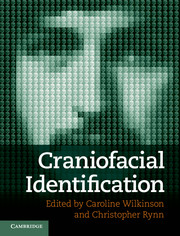Book contents
- Frontmatter
- Contents
- Contributors
- Part I Identification of the Living
- Chapter 1 Familiar face recognition
- Chapter 2 Unfamiliar face recognition
- Chapter 3 EFIT-V
- Chapter 4 Facial recall and computer composites
- Chapter 5 Facial ageing
- Chapter 6 Age progression and regression
- Chapter 7 Computer-assisted age progression
- Chapter 8 Facial recognition from identification parades
- Chapter 9 Virtual human identification line-ups
- Chapter 10 Computer-generated face models
- Chapter 11 Recognising and learning faces in motion
- Chapter 12 Facial image comparison
- Chapter 13 Three-dimensional facial imaging
- Part II Identification of the Dead
- Index
- Plate Section
- References
Chapter 8 - Facial recognition from identification parades
Published online by Cambridge University Press: 05 May 2012
- Frontmatter
- Contents
- Contributors
- Part I Identification of the Living
- Chapter 1 Familiar face recognition
- Chapter 2 Unfamiliar face recognition
- Chapter 3 EFIT-V
- Chapter 4 Facial recall and computer composites
- Chapter 5 Facial ageing
- Chapter 6 Age progression and regression
- Chapter 7 Computer-assisted age progression
- Chapter 8 Facial recognition from identification parades
- Chapter 9 Virtual human identification line-ups
- Chapter 10 Computer-generated face models
- Chapter 11 Recognising and learning faces in motion
- Chapter 12 Facial image comparison
- Chapter 13 Three-dimensional facial imaging
- Part II Identification of the Dead
- Index
- Plate Section
- References
Summary
Introduction
Identification parades are one of the most common means of identifying a perpetrator of a crime and can be powerful evidence in securing convictions in criminal cases. In an identification parade (also known as a line-up) a suspect is placed amongst a number of similar-looking people (foils) and the task for the witness is to either select the person they recognise as being the culprit, or state the culprit is not there. Unfortunately, witnesses do not always correctly identify the culprit from a line-up and in some cases innocent people are wrongly identified. This issue has been investigated by the Innocence project, who at the time of writing, have been involved in 251 exonerations based on DNA evidence in the USA. Of these cases approximately 75% of those convicted were cases of mistaken identity (Innocence Project at: http://www.innocenceproject.org/). Several similar organisations have developed worldwide such as the UK Innocent Network, the Australian Innocence Network and the Innocence Project New Zealand, all with the aim to overturn convictions of those who have been wrongfully imprisoned. One real life case of someone who was exonerated by the Innocent Project is Calvin Willis; he was wrongly accused of rape and served 22 years before DNA evidence proved he was innocent. Even though one of the police reports stated the victim did not see her attacker’s face, she was shown a line-up and said she was told to pick the man without the full beard. She later testified that she did not choose anyone, although the police said she picked Willis. Willis’s name only came into the investigation because the victim’s neighbours had mentioned Willis’s name when discussing who might have committed the crime. Even with all these flaws in the investigation the jury still convicted Willis and sentenced him to life (for more details of this case see Innocence Projects webpage at: http://www.innocenceproject.org/Content/297.php). This illustrates how powerful eyewitness evidence can be in the courtroom, even when there are obvious flaws in the way it has been obtained.
- Type
- Chapter
- Information
- Craniofacial Identification , pp. 86 - 100Publisher: Cambridge University PressPrint publication year: 2012



